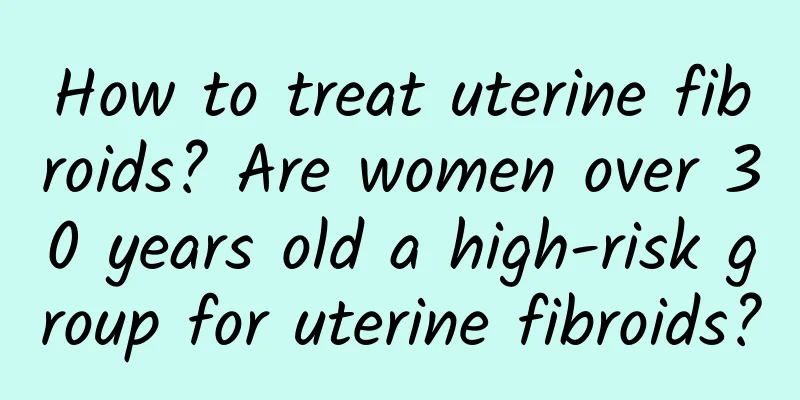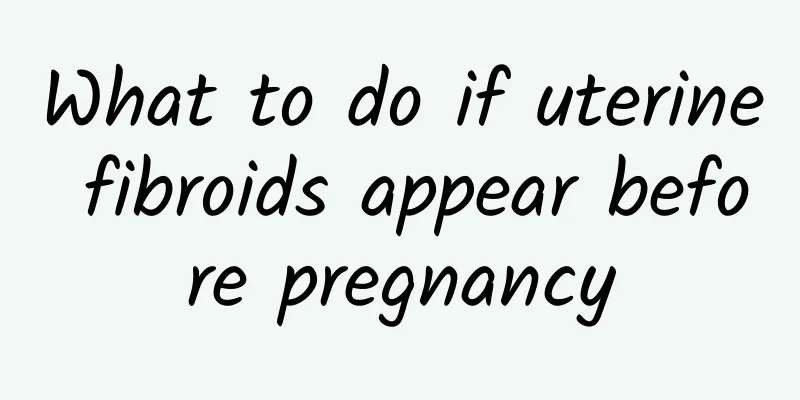How to treat uterine fibroids? Are women over 30 years old a high-risk group for uterine fibroids?

|
Uterine fibroids are the most common tumors in the female reproductive tract. According to statistics, more than 20% of women aged 30 have single or multiple fibroids of different sizes in their uterus. Most of the causes of uterine fibroids are related to the level of estrogen in the body, because uterine fibroids are common in women of childbearing age. After women of childbearing age develop uterine fibroids, the fibroids will continue to grow and develop, and after menopause, the fibroids will stop growing or even shrink. The symptoms of uterine fibroids depend on the location and size of the fibroids. The uterine wall is composed of an inner mucosal layer, an outer serosa layer, and a middle muscle layer. Fibroids that are longer than the muscle layer will gradually grow and develop in different directions. If the tumor compresses the bladder, frequent urination or poor urination will occur, and compressing the rectum will cause poor defecation; some fibroids will also hinder the implantation of fertilized eggs, leading to infertility or miscarriage after pregnancy. The most common symptoms are the growth of fibroids under the mucosa, the expansion of the mucosal area, resulting in a shortened menstrual cycle, increased menstrual volume, and prolonged menstruation leading to anemia. After suffering from uterine fibroids, if the tumor is small and there are no discomfort symptoms, you should go to the hospital for a check-up every 3 months and pay attention to the changes of the fibroids at any time. If the uterus is enlarged to 3 months of pregnancy due to fibroids, or if the uterus is poorly contracted, menorrhagia, and secondary severe anemia are caused by large fibroids, active treatment should be given. The surgical treatment method can be determined according to the specific situation, using a simple myomectomy or a total hysterectomy. Radiofrequency interventional therapy is to extend the therapeutic device directly from the vagina to the tumor. Under computer control, fibroid cells are dehydrated and coagulated through the biological high heat effect, and are absorbed or discharged by the body to achieve the treatment purpose. Conservative treatment is mainly the differentiation treatment of traditional Chinese medicine syndrome. Clinically, traditional Chinese medicine that promotes blood circulation, eliminates blood stasis, softens and disperses nodules is used. By improving the patient's qi stagnation and blood stasis state, uterine fibroids are reduced and symptoms are improved. |
<<: How to treat uterine fibroids? What are the treatments for uterine fibroids?
Recommend
What are the main symptoms of irregular menstruation?
What are the main characteristics of irregular me...
Symptoms of uterine fibroids. Will uterine fibroids cause a mass in the lower abdomen?
Experts introduce the symptoms of uterine fibroid...
What to eat for uterine fibroids
What to eat for uterine fibroids? The appearance ...
Experts introduce three common methods to prevent dysmenorrhea
Dysmenorrhea is a gynecological disease that ofte...
How to identify pelvic inflammatory disease? Know the corresponding symptoms
Pelvic inflammatory disease has seriously threate...
There are 3 types of ovulatory dysfunctional uterine bleeding
Ovulatory functional uterine bleeding is a diseas...
If women take good care of the prevention of ovarian cysts
In life, how can women prevent ovarian cysts ? Ov...
What is the best medicine for women with irregular menstruation? What should women pay attention to when they have irregular menstruation?
What medicine is best for irregular menstruation?...
Symptoms of vaginitis
Vaginitis is an inflammation of the vaginal mucos...
A new option for surgery for morbid obesity! Gastric Band Weight Loss Surgery
Gastric banding is currently the most important r...
What factors cause cervical hypertrophy?
The phenomenon of cervical hypertrophy is very co...
Fruits are high in fiber, so you won’t gain weight even if you eat them as a main meal? Traditional Chinese Medicine: Debunking 4 myths about weight loss and conditioning according to your physical condition
Rome was not built in a day, and obesity "fa...
Can chronic cervicitis in women be completely cured? Five methods to treat chronic cervicitis in women
The health impact of chronic cervicitis on people...
What are the symptoms of uterine fibroids and how to prevent them?
Uterine fibroids are most likely to occur in preg...
The main causes of mild cervical erosion
Cervical erosion is a gynecological disease that ...


![[Video version] Is soy milk "green milk" more nutritious than cow's milk? 6 magical effects in preventing high blood pressure and diabetes, these people should not](/upload/images/67dcfc897bc70.webp)






